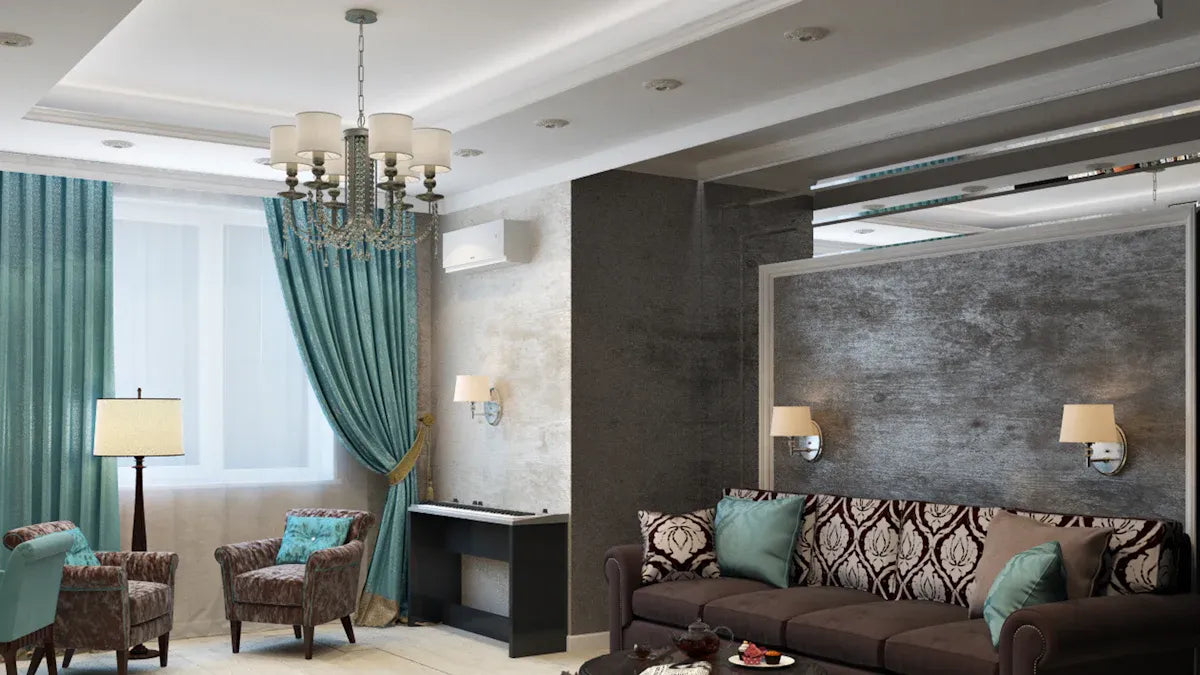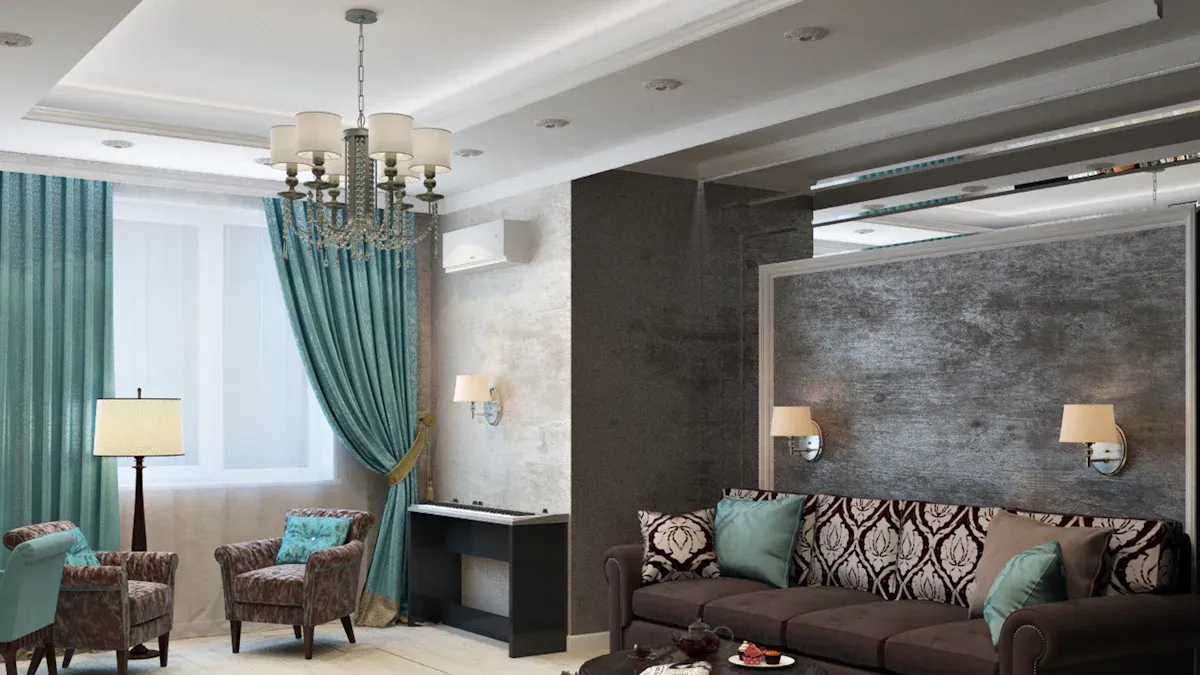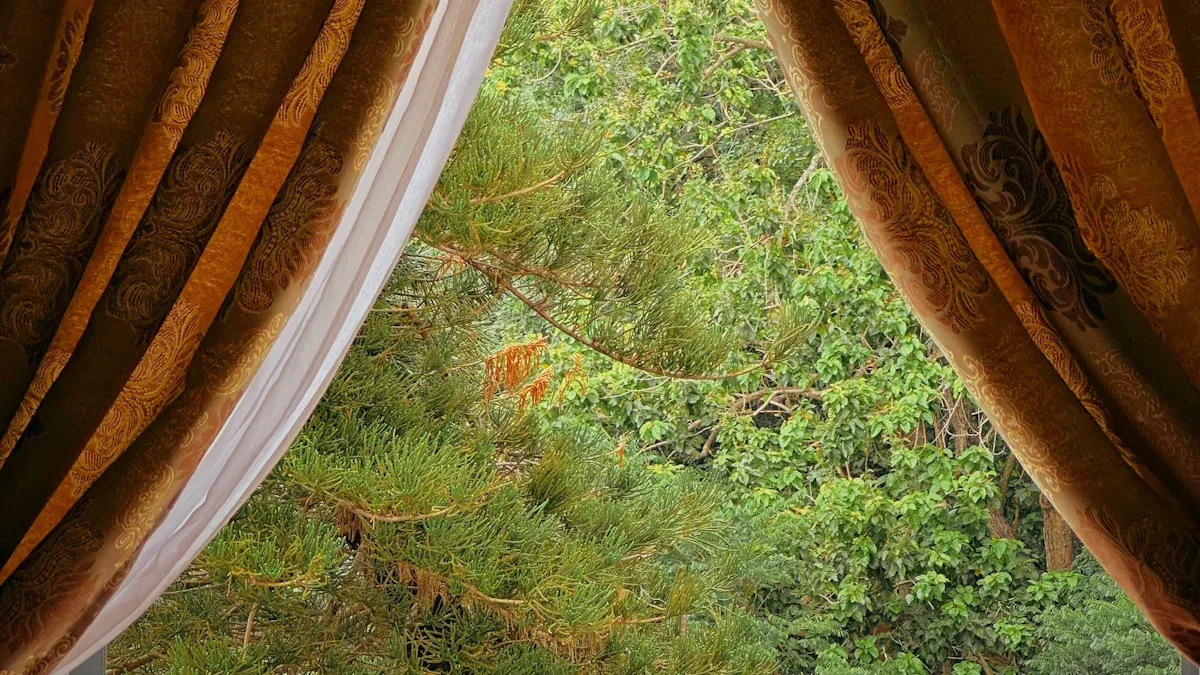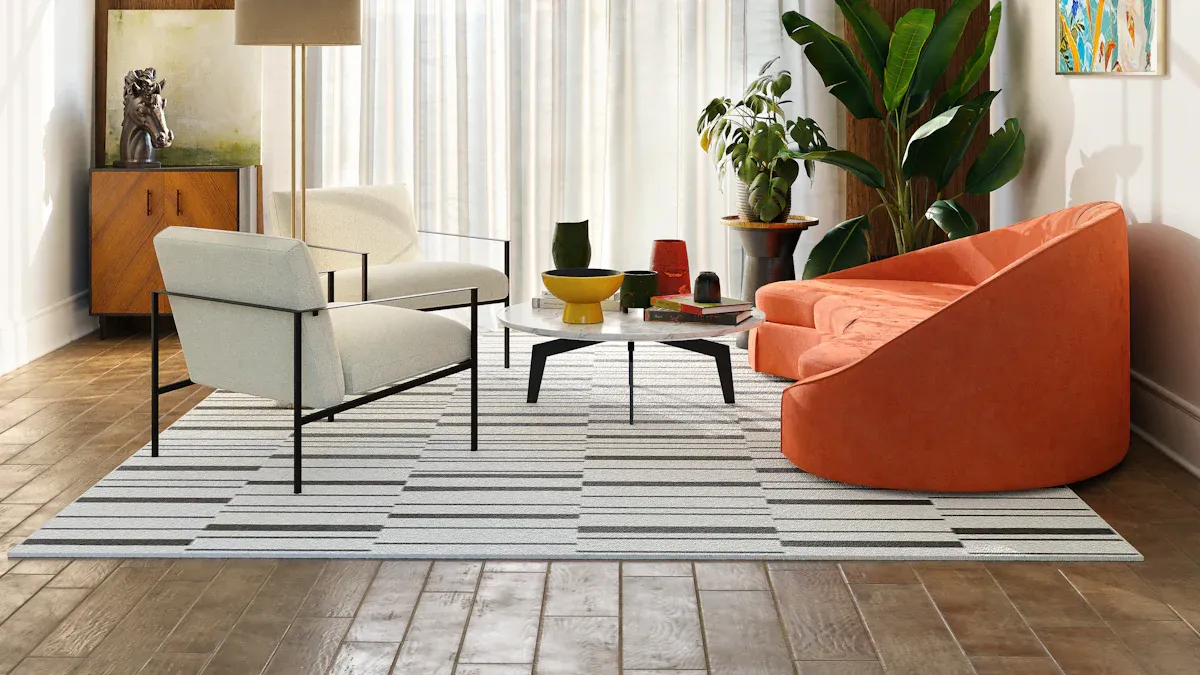
From Measurement to Installation: Mastering the Art of Custom Drapes

Looking for a way to elevate your home’s style? Custom drapes might be your answer. These window treatments are made just for you, ensuring they fit perfectly and match your unique taste. Unlike store-bought options, they offer top-notch quality and endless design possibilities. Whether you want bold patterns or soft neutrals, you’ll have the freedom to create something truly personal. Plus, they don’t just look great—they add a polished, tailored feel to your space that’s hard to beat.
Tip: Custom drapes can instantly transform a room, making it feel more refined and inviting.
Key Takeaways
Custom drapes fit your windows perfectly, improving looks and use.
Pick from many fabrics and designs to match your style.
Custom drapes last longer, saving money on replacements later.
They help control light and add privacy for comfort.
The process includes checking needs, measuring, and choosing materials.
Benefits of Custom Drapes
Perfect Fit for Any Window
One of the biggest advantages of custom drapes is their ability to fit your windows perfectly. Unlike mass-produced options, which often leave gaps or hang awkwardly, custom drapes are tailored to your window's exact measurements. This precision ensures a polished look and improves functionality.
For example, custom drapes can be designed to fit within 1/16th of an inch of your window's dimensions. This level of accuracy not only enhances the overall appearance but also improves insulation and light control. Take a look at how custom drapes compare to ready-made options:
Feature |
Custom Drapes |
Mass-Produced Drapes |
|---|---|---|
Fit Precision |
Within 1/16th of an inch |
Varies, often less precise |
Insulation Effectiveness |
High, tailored to window specs |
Low, generic sizing |
Aesthetic Customization |
Fully customizable |
Limited options |
Installation Fit |
Edge-to-edge or overlaps as needed |
Often gaps due to sizing issues |
Custom drapes also account for hardware placement, ensuring they hang beautifully and function seamlessly. This attention to detail makes them a favorite among homeowners looking for both style and practicality.
Design Flexibility to Match Your Style
When it comes to expressing your personal style, custom drapes offer unmatched flexibility. You can choose from a wide range of fabrics, colors, patterns, and finishes to create a look that complements your home perfectly. Whether you prefer bold, dramatic designs or soft, understated tones, the possibilities are endless.
Custom drapes allow you to mix and match elements to suit your taste. Want blackout lining for your bedroom but sheer panels for your living room? No problem. You can even select unique hardware, like decorative rods or finials, to add an extra touch of personality.
A 2023 study by Accenture found that 64% of global consumers are willing to pay more for personalized products. This growing demand for customization highlights how much people value having options that reflect their individuality. With custom drapes, you can create a space that feels truly yours.
Tip: Think about the mood you want to set in each room. Lighter fabrics can make a space feel airy, while heavier materials add warmth and coziness.
Superior Quality and Durability
Custom drapes are built to last. Unlike standard options, which often use lower-quality materials, custom drapes are crafted with care and attention to detail. This means they can withstand daily wear and tear without losing their charm.
According to industry reports, custom drapes are known for their high craftsmanship and durability. Here's how they stack up against standard drapes:
Feature |
Custom Drapes |
Standard Drapes |
|---|---|---|
Quality |
Variable, often lower quality |
|
Durability |
Long-lasting, withstands wear |
Prone to fraying and fading |
Personalization |
Tailored to specific needs |
Limited options |
Investing in custom drapes means you won't have to worry about replacing them frequently. Their superior quality ensures they maintain their beauty and functionality for years, making them a smart choice for your home.
Note: While custom drapes may cost more upfront, their durability and timeless appeal make them a worthwhile investment in the long run.
Practical Benefits: Light Control and Privacy
Custom drapes do more than just look good—they give you control over light and privacy in your home. Imagine being able to adjust the brightness of a room or block out prying eyes with ease. That’s the kind of convenience custom drapes bring to the table.
Light Control Made Easy
Do you love waking up to soft, natural light but hate the glare during the day? Custom drapes let you strike the perfect balance. You can choose fabrics that filter light gently or go for blackout options that completely darken a room. This flexibility makes them ideal for spaces like bedrooms, nurseries, or home theaters.
For example, sheer drapes can soften sunlight in your living room, creating a warm and inviting atmosphere. On the other hand, heavier fabrics with lining can block out harsh sunlight, keeping your space cool and comfortable.
Tip: Pair custom drapes with layered treatments, like blinds or shades, for even more control over light levels throughout the day.
Privacy Without Compromise
Privacy is essential, especially in rooms like bedrooms or bathrooms. Custom drapes give you the ability to shield your home from outside views while still maintaining style. Unlike standard options, which may leave gaps or fail to cover your windows fully, custom drapes fit perfectly, ensuring complete coverage.
You can also choose dual-function designs, like drapes with sheer panels for daytime privacy and heavier panels for nighttime. This way, you don’t have to sacrifice natural light for privacy during the day.
Why It Matters
Having control over light and privacy isn’t just about comfort—it’s about creating a space that works for you. Whether you want to enjoy a lazy Sunday morning in a darkened room or keep your home safe from curious neighbors, custom drapes make it possible.
Note: Custom drapes are a smart investment for anyone who values both functionality and style. They let you tailor your space to your exact needs, making your home feel more secure and comfortable.
How to Choose the Right Custom Drapes

Assessing Your Needs and Preferences
Choosing custom drapes starts with understanding what you want and need. Think about the purpose of the drapes in each room. Are you looking for privacy, light control, or purely decorative elements? For example, blackout drapes might be perfect for your bedroom, while sheer panels could work better in a sunlit living room.
Consider the mood you want to create. Do you want a cozy, warm vibe or something light and airy? Your preferences will guide your choices in fabric, color, and style. Also, think about how the drapes will complement your existing decor. If your furniture has bold patterns, you might prefer solid-colored drapes to balance the look.
Tip: Take a moment to visualize how the drapes will look in your space. This can help you narrow down your options and avoid feeling overwhelmed by the choices.
Measuring Your Windows Accurately
Accurate measurements are key to ensuring your custom drapes fit perfectly. Here’s a step-by-step guide to help you measure your windows like a pro:
Measure the width (left to right) first, then the height (top to bottom).
Record all measurements to the nearest 1/8 inch, clearly labeling width and height.
For outside mounts, place the rod 6 inches above the window and extend it 6 inches on each side.
Specify the width for each panel, with a minimum of 24 inches.
Choose the desired drapery length based on where you’ll mount the rod.
Getting these measurements right ensures your drapes hang beautifully and function as intended. If you’re unsure, don’t hesitate to ask a professional for help.
Note: Accurate measurements not only improve the fit but also enhance the overall aesthetic of your custom drapes.
Selecting the Right Fabrics and Styles
The fabric and style of your custom drapes can make or break the look of your space. Different fabrics offer unique benefits, so it’s important to choose one that suits your needs. Here’s a quick comparison to help you decide:
Fabric Type |
Characteristics |
Light Control |
Durability |
Maintenance |
Aesthetic Use |
|---|---|---|---|---|---|
Eco-Silk |
Smooth, elegant |
Good |
Moderate |
Delicate |
Living rooms, dining rooms |
Sheer Fabrics |
Light, airy |
Poor |
Moderate |
Easy |
Layering, casual spaces |
Performance Fabrics |
Varies |
Good |
Excellent |
Easy |
High-traffic areas, kids' rooms |
Organic Cotton |
Soft, breathable |
Moderate |
Good |
Easy |
Versatile, allergy-prone areas |
Bamboo Blends |
Smooth, natural |
Good |
Good |
Moderate |
Eco-conscious homes |
Smart Fabrics |
Varies |
Excellent |
Good |
Easy |
Tech-savvy homes |
When selecting a style, think about how the drapes will interact with your space. Floor-length drapes add elegance, while shorter styles feel more casual. You can also mix and match fabrics for a layered look that combines functionality and beauty.
Recent market studies show that homeowners are increasingly drawn to personalized solutions that reflect their individual styles. This trend is driven by the desire for smart, energy-efficient window coverings and the growing popularity of home remodeling projects. Companies like Lutron Electronics are even offering innovative smart drapes to meet this demand.
Tip: Don’t forget to factor in maintenance. Some fabrics, like organic cotton, are easier to clean, while others, like eco-silk, require more care.
Considering Functional Requirements
When choosing custom drapes, it’s not just about how they look. You also need to think about how they’ll work in your space. Functional requirements play a big role in making sure your drapes meet your everyday needs. Let’s break down what you should consider.
Durability for Daily Use
Your drapes should stand up to the demands of your lifestyle. If you have kids or pets, you’ll want fabrics that resist stains and wear. For high-traffic areas, performance fabrics are a smart choice. They’re designed to handle frequent use without losing their charm.
Tip: Look for materials labeled as “performance” or “high-durability.” These options are often easier to clean and maintain, saving you time and effort.
Light and Temperature Control
Think about how much light you want in each room. Do you need blackout drapes for a bedroom or something sheer for a sunroom? Custom drapes let you pick fabrics that match your light control needs. They can also help regulate temperature. Heavier fabrics with thermal linings can keep your home cozy in winter and cool in summer.
Here’s a quick comparison of fabric types and their functional benefits:
Fabric Type |
Light Control |
Temperature Regulation |
Best For |
|---|---|---|---|
Blackout Fabrics |
Excellent |
High |
Bedrooms, nurseries |
Sheer Fabrics |
Minimal |
Low |
Living rooms, sunrooms |
Thermal Linings |
Moderate to High |
Excellent |
Drafty windows, cold areas |
Ease of Operation
How you’ll open and close your drapes matters too. Motorized drapes are a great option if you want convenience. They’re especially useful for hard-to-reach windows or large spaces. On the other hand, traditional pull cords or tiebacks might work better for smaller rooms.
Note: If you’re considering motorized drapes, make sure they’re compatible with your smart home system.
Reliable Service and Delivery
When working with a custom drape provider, you’ll want to ensure they offer reliable service. Interior designers often emphasize the importance of timely delivery and clear communication. This is because delays or miscommunication can disrupt your home improvement plans. High-quality service ensures your drapes arrive on time and meet your expectations.
Custom drapes aren’t just about aesthetics—they’re about creating a space that works for you. By focusing on functional requirements, you’ll end up with window treatments that look amazing and make your life easier.
The Customization Process for Custom Drapes

Initial Consultation and Design Discussion
The journey to perfect custom drapes begins with an initial consultation. This step helps you define your needs and preferences while ensuring the final product aligns with your vision. During this discussion, you’ll work with a professional to assess key factors like budget, space, and design goals.
Here’s a quick guide to what’s typically covered:
Consideration |
Description |
|---|---|
Budget and spatial requirements |
Assess the financial limits and space available for drapery installation. |
Primary purpose |
Define the main function of the drapes (e.g., privacy, aesthetics). |
Maintenance objectives |
Consider current and future maintenance needs for the drapes. |
Energy efficiency |
Evaluate the insulative properties and energy-saving potential of materials. |
Existing décor |
Take into account the current design and architectural style of the space. |
Branding and color schemes |
Align drapery choices with the brand identity and color palette. |
This consultation ensures every detail is tailored to your home. Whether you’re looking for energy-efficient materials or a design that complements your décor, this step sets the foundation for a successful customization process.
Tip: Bring photos of your space to the consultation. Visual references can help the designer understand your style better.
Choosing Fabrics, Hardware, and Styles
Once your needs are clear, it’s time to select the materials and design elements for your custom drapes. You’ll have access to a wide range of options, allowing you to create a look that’s uniquely yours.
Here are some popular choices:
Hand-crafted stainless-steel drapery hardware that is rust-proof and guaranteed for a perfect fit.
Tailored Pleat Drapes & Curtains, which are fully customizable with fabrics, patterns, and motorized track options.
High-quality textiles like imported silks (dupioni and taffeta), cotton duck canvas, flax linen, and performance fabrics by Sunbrella.
These options give you the flexibility to mix and match styles, textures, and finishes. Whether you want luxurious silk drapes for your dining room or durable performance fabrics for a kid-friendly space, there’s something for every need.
Note: Motorized tracks are a great choice for convenience, especially for large windows or hard-to-reach areas.
Production Timeline and Installation Process
After finalizing the design, the production phase begins. Skilled artisans craft your drapes with precision, ensuring every detail meets your specifications. The timeline for production varies depending on the complexity of the design, but most custom drapes are ready within 4–6 weeks.
Once the drapes are complete, the installation process ensures they fit perfectly and function seamlessly. Professionals handle the setup, making sure the hardware is secure and the drapes hang beautifully. This step guarantees a polished look that enhances your space.
Tip: Schedule installation at a time when you can be home to review the final setup and make adjustments if needed.
Custom drapes are more than just window treatments—they’re a reflection of your style and a practical addition to your home. From consultation to installation, every step is designed to give you a product that’s both beautiful and functional.
Cost Considerations for Custom Drapes
Factors That Influence Pricing
When it comes to custom drapes, several factors can impact the final cost. Understanding these can help you plan your budget more effectively. Here’s what typically drives the price:
Consultation Charges: Professional designers often charge fees to assess your space and provide recommendations.
Material Matters: The type and quality of fabric play a big role. Luxurious materials like silk or velvet cost more than cotton or polyester.
Style and Drapery Quality: Intricate designs or premium craftsmanship can increase the price.
Drapery Size: Larger windows require more fabric, which naturally raises the cost.
Accessories Expense: Items like decorative rods, finials, and tiebacks add to the total.
Drapery Functionality: Features like motorization or thermal linings can make your drapes more expensive.
Drapery Installation: Professional installation costs vary depending on the complexity of the setup.
Tip: If you’re working with a tight budget, prioritize the features that matter most to you, like fabric quality or functionality.
Tips for Budgeting Without Compromising Quality
You don’t have to break the bank to get beautiful custom drapes. With a little planning, you can achieve the look you want without overspending. Here are some tips to help you stay on budget:
Choose Fabrics Wisely: Opt for mid-range materials like cotton or linen. They’re durable and stylish without the high price tag of luxury fabrics.
Simplify the Design: Go for classic styles that require less labor. Avoid overly intricate patterns or embellishments.
Measure Accurately: Double-check your window measurements to avoid costly mistakes.
Consider DIY Installation: If you’re handy, installing the drapes yourself can save you money.
Shop Smart for Accessories: Look for affordable yet stylish hardware options.
Note: Investing in durable materials might cost more upfront, but it saves you money in the long run by reducing the need for replacements.
Understanding the Value of Custom Drapes
Custom drapes may seem pricey at first, but they offer incredible value that off-the-shelf options simply can’t match. Here’s why they’re worth the investment:
They’re tailored to fit your windows perfectly, eliminating the need for multiple panels or adjustments.
High-quality materials ensure they last longer, making them a cost-effective choice over time.
Custom drapes elevate the overall look of your room, giving it a polished and cohesive design.
Description |
|
|---|---|
Fabric |
Premium fabrics enhance durability and style. |
Design Complexity |
Unique designs add character to your space. |
Curtain Rod Length |
Longer rods may require more material and cost. |
By choosing custom drapes, you’re not just buying window treatments—you’re investing in a solution that combines beauty, functionality, and longevity.
Tip: Think of custom drapes as a long-term investment. Their durability and timeless appeal make them a smart choice for any home.
Custom Drapes vs. Ready-Made Options
Key Differences in Quality and Fit
When it comes to quality and fit, custom drapes stand in a league of their own. Ready-made options are mass-produced, which means they’re designed to fit a range of window sizes—not your specific ones. This often leads to awkward gaps or drapes that hang unevenly. Custom drapes, on the other hand, are tailored to your exact window measurements. They fit like a glove, giving your space a polished and professional look.
The materials also set them apart. Store-bought drapes often use lower-quality fabrics that can fade or fray over time. Custom drapes are crafted with premium materials, ensuring they last longer and maintain their beauty. If you’re looking for something that feels luxurious and fits perfectly, custom drapes are the way to go.
Tip: If you’ve got uniquely shaped windows, custom drapes are your best bet for a flawless fit.
When Custom Drapes Are the Better Choice
Custom drapes shine in situations where personalization and durability matter most. Do you have a specific vision for your space? Maybe you want a fabric that matches your sofa or a pattern that complements your wallpaper. Custom drapes let you bring that vision to life.
They’re also ideal for rooms where functionality is key. Need blackout drapes for a bedroom or thermal-lined ones to keep your home cozy? Custom options can meet those needs perfectly. Plus, if you’re working with large or oddly shaped windows, ready-made drapes just won’t cut it.
Think about the long-term benefits too. Custom drapes don’t just look better—they perform better. They’re built to last, saving you the hassle of frequent replacements.
Note: If you’re planning to sell your home, high-quality custom drapes can even boost its resale value.
Comparing Costs and Long-Term Benefits
At first glance, custom drapes might seem expensive. They typically range from $200 to $1500 or more per window panel, while ready-made options cost between $20 and $250. But here’s the thing—custom drapes are an investment. Their superior durability means you won’t need to replace them as often.
They also offer practical benefits that save you money over time. Features like thermal linings can reduce energy bills by keeping your home insulated. And let’s not forget the added value they bring to your home’s overall aesthetic and resale appeal.
Here’s a quick breakdown of the cost comparison:
Custom Drapes: $200–$1500+ per panel, but they last longer and offer energy savings.
Ready-Made Drapes: $20–$250 per panel, but they may need frequent replacements.
In the long run, custom drapes provide better value. They combine style, functionality, and durability in a way that ready-made options simply can’t match.
Tip: Think of custom drapes as a one-time investment that pays off in comfort, style, and savings.
Custom drapes bring a unique blend of personalization, quality, and style to your home. They’re more than just window treatments—they’re a statement piece that elevates your space. With the growing demand for luxury and customized decor, it’s clear that homeowners value the sophistication and functionality these drapes provide. The high-end curtain market, valued at $4.3 billion in 2023, reflects this trend, with projections reaching $6.34 billion by 2032. By tailoring your drapes to your needs and preferences, you can create a home that feels both stylish and uniquely yours.
FAQ
What’s the difference between custom drapes and ready-made ones?
Custom drapes are tailored to your window’s exact size and style preferences. Ready-made drapes come in standard sizes and limited designs. Custom options offer better fit, quality, and personalization, while store-bought ones are quicker and cheaper.
How long does it take to get custom drapes?
The process usually takes 4–6 weeks. This includes consultation, design, production, and installation. Complex designs or rare fabrics might extend the timeline slightly.
Are custom drapes worth the cost?
Absolutely! Custom drapes last longer, fit perfectly, and elevate your home’s look. They’re an investment in quality and style, saving you money on replacements and improving energy efficiency.
Can I install custom drapes myself?
You can, but professional installation ensures a flawless fit. Experts handle hardware placement and adjustments, saving you time and effort. If you’re handy, DIY is an option for simpler setups.
What fabrics work best for custom drapes?
It depends on your needs. Cotton and linen are versatile and durable. Silk adds elegance, while blackout or thermal fabrics improve light control and insulation. Choose based on your room’s function and style.










